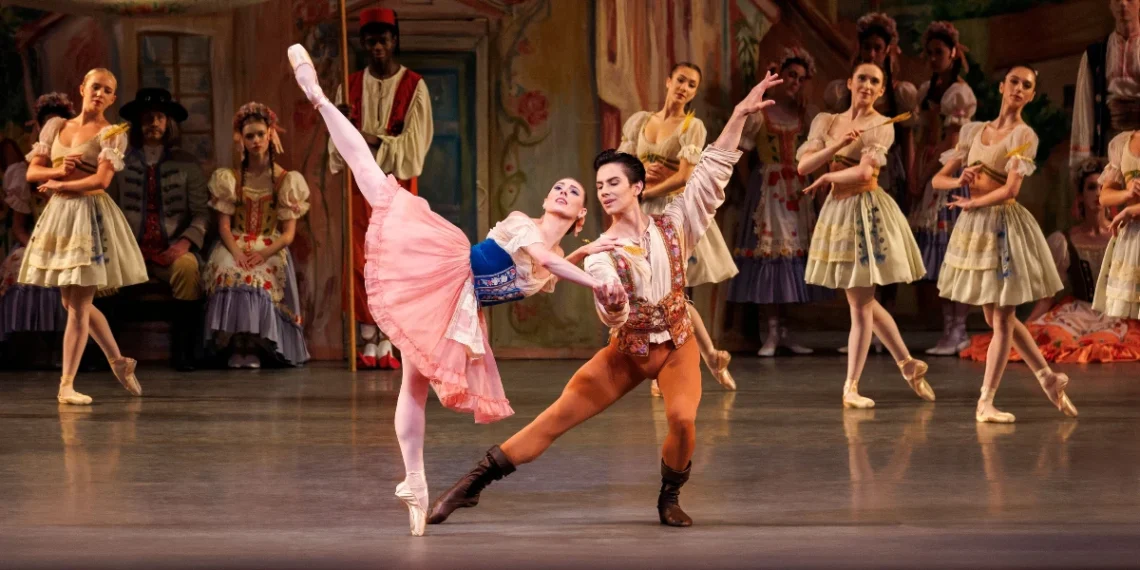NYCB Coppélia Review
March 29, 2025 | The Kennedy Center – Washington, D.C., USA
New York City Ballet brought its bright and sparkly production of Coppélia to the Kennedy Center Opera House for a six-performance run at the end of March.
A romantic comedy and a mystery thriller in equal measure, Coppélia has long been considered as one of the greatest comic ballets in the 19th-century classical repertory. Its original production was created by Arthur Saint-Léon for the Opéra de Paris in 1870; the ballet was later restaged by Marius Petipa and Enrico Cecchetti for St. Petersburg’s Mariinsky Ballet.
You may also like...
ABT The Winter’s Tale Review: Familiar Steps, Fearless Chemistry
As The Winter's Tale unfolded, it was the combination of a large production team and the dancers’ deep commitment to character that gave the ballet its depth.
Chamber Dance Project Red Angels Review: Chamber Dance Delights at Harman Hall
Chamber Dance Project's mission - as demonstrated in Red Angels - has always been to showcase the interplay between dancers and live music.
NYCB Coppélia Review
New York City Ballet’s current production of Coppélia was created in 1974 by George Balanchine and Alexandra Danilova. (Danilova danced the ballet’s title role through the 1930s and 40s and was regarded as one of the most notable Swanildas in the ballet’s history.)
Together, they recreated this three-act ballet based on their memories from their dancing days. Balanchine put his own stamp on the third act, recreating it anew and adding his own choreography.
Coppélia’s plot was inspired by the dark tales of E.T.A. Hoffmann, “Der Sandmann” (“The Sandman”) and “Die Puppe” (“The Doll”). Yet the ominous overtones of the ballet’s scenario are just a pretext for an improbable and wickedly funny action, replete with colorful characters and exuberant dancing.
The ballet’s story is set in a Galician village and centers on four principal characters: the two young lovers, Swanilda and Frantz, an eccentric village toymaker Dr. Coppélius, and his daughter Coppélia.
A happy-go-lucky Frantz is in love with a vivacious and sweet Swanilda and intends to marry her; but at the same time, he is also smitten and intrigued by the beautiful and enigmatic Coppélia, thus putting his wedding plans in trouble.
Yet the ingenious and intrepid Swanilda fights for her happiness by revealing the identity of her mysterious rival, proving that Coppélia is just a lifeless, mechanical doll. She wins back her straying fiancé, and the third act’s wedding celebrations triumphantly culminate the whole affair.

During Saturday's evening performance, Tiler Peck and Roman Mejia delivered a pitch-perfect rendition of the principal roles of Swanilda and Frantz.
With her sunny and cheerful personality, Peck is a natural Swanilda, her dancing crispy clean, vibrant, and highly animated. Her Swanilda was utterly endearing whether she was flirting was Frantz or trying to connect with her enigmatic contender for Frantz’s affection, the motionless and stone-faced Coppélia.
In the first act, demonstrating a soft and gentle side of her heroine, Peck danced “The Ear of Wheat” scene, in which Swanilda searches for a confirmation of her lover’s fidelity, with tenderness and genial charm.
But it was in the suspense-driven Act II that Peck revealed her outstanding comic verve. Driven by burning jealousy and desire to find out the truth, her Swanilda was incredibly funny when she, together with her girlfriends, fearlessly broke into the workshop of the old Coppélius and impersonated his precious doll, making him believe that his mechanical creation indeed came to life.

The vividness and animation of Peck’s pantomime was as brilliant as the naturalness and expressiveness of her dancing.
She effortlessly breezed through the Spanish reel and Scottish fandango of the second act and danced with a breathtaking skill and ardor in the Act’s III wedding pas de deux.
Mejia was an ardent and affable Frantz – a gullible youth, confused rather than deceitful. His hero was obviously in love with Swanilda; yet he was genuinely infatuated with the beautiful Coppélia, whose decorous demeanor was a complete opposite to the upbeat and vivacious personality of his girlfriend.
It appeared that he was smitten with both women and simply couldn’t make up his mind.

Mejia’s dancing, particularly in Act III’s wedding pas de deux, was polished and technically accomplished.
I was particularly impressed with his high and powerful leaps which he delivered with a remarkable assurance and panache; and his comic timing in the pantomime scenes was perfect.
Harrison Call gave a convincing portrayal of the eccentric toymaker Dr. Coppélius. He played his role with a notable theatrical touch. His hero looked overjoyed and triumphant when he saw that his beloved Coppélia had come to life; and then his happiness came crashing down when he realized that he was fooled by Swanilda, pretending to be Coppélia.
We laughed at his alchemic attempt to siphon life from the sleeping Frantz to make Coppélia a human being; but at the same time, we felt for his loneliness and his shattered dreams.
The company’s corps de ballet delivered the national dances of the first act with a lively spirit and dynamism (though the costumes for the corps looked dated and in need of refurbishment).
And a special note goes to the ensemble of adorable children – students of the schools from the local area, prepared and rehearsed by Dena Abergel and Arch Higgins – who danced with excitement and dedication in the Waltz of the Golden Hours in the ballet’s final act.
Featured Photo of Tiler Peck and Roman Mejia in New York City Ballet’s production of George Balanchine and Alexandra Danilova’s Coppélia. Photo by Erin Baiano.









